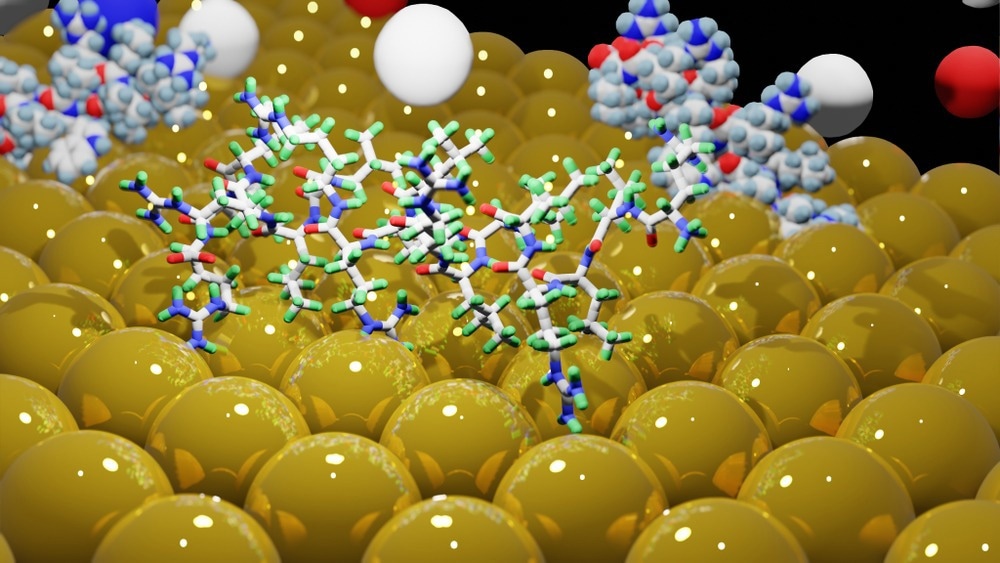The sterility of a product indicates the absence of living microorganisms. Hence, nanoparticles utilized in biomedical applications and prepared via chemical synthesis are subjected to sterilization. However, this process has not yet been explored for electrostatically stabilized gold (Au) nanoparticles.

Study: Impact of Sterilization on the Colloidal Stability of Ligand-Free Gold Nanoparticles for Biomedical Applications. Image Credit: sanjaya viraj bandara/Shutterstock.com
An article published in Langmuir discussed the physicochemical properties of ligand-free colloidal Au nanoparticles generated by a laser process and subjected to steam sterilization and sterile filtration. Here, the mass concentration and particle size of Au nanoparticles were examined to obtain physicochemical insights into the particle growth process.
The Au nanoparticles obtained via electrostatic stabilization exhibited long-term colloidal stability without surfactants or ligands. Furthermore, particle growth following autoclaving led to cluster-based ripening of smaller Au nanoparticles (5 nanometers in size). In contrast, larger Au nanoparticles (10 and 30 nanometers in size) remained stable.
This work demonstrated that irrespective of particle size, sterile filtration can be a practical approach to sterilize Au nanoparticles without impacting their colloidal stability. Finally, the sterilization effect on Au nanoparticle's functionality was evaluated in proton therapy (PT) based on the generation of reactive oxygen species (ROS).
Autoclaving the Au nanoparticles led to a substantial loss in activity in nanoparticles of 5 nanometers in size due to the reduction in specific surface area and particle growth-induced surface restructuring.
The filtered Au nanoparticles showed a two-fold improved release of ROS at a concentration of 30 parts per million. Thus, the research findings of this work highlighted the need for tailoring the sterilization technique for ligand-free Au nanoparticles to suit the desired biomedical application, focusing on the concentration and particle size.
Au Nanoparticles in Radiation Therapies
Au nanoparticles have been extensively used in biomedical applications because of their nontoxicity, biocompatibility, size, shape-controlled electrical and optical characteristics, as well as bioconjugation ability. These unique properties make Au nanoparticles intriguing candidates for various applications, including imaging, drug delivery, and sensing.
Recently, Au nanoparticles have emerged as nanosensitizers for radiation therapies based on protons and X-rays. PT with nanoparticles as sensitizers has emerged as an effective tumor treatment owing to conformed dose delivery to the tumor cells with reduced side effects on healthy tissues compared to traditional X-ray therapy.
PT is extremely useful in treating cancers in sensitive organs like the brain. Many studies have demonstrated that metallic nanoparticles can improve the efficacy of PT through various mechanisms, such as catalytic reactions or secondary electron emission at the nanoparticle–water interface.
Although the underlying mechanism is uncertain, most studies imply that the presence of metallic nanoparticles causes the generation of ROS, which results in a greater mortality rate of the targeted tumor cells in PT. Au is one of the most investigated elements in nanoparticle PT due to its high atomic number, biocompatibility, density, and chemical inertness.
Sterilization of Ligand-Free Au Nanoparticles
In the present study, ligand-free Au nanoparticles of three different sizes (5, 10, and 30 nanometers) were prepared via laser ablation in liquid (LAL). The long-term stability of the prepared Au nanoparticles was evaluated, followed by sterilization via sterile filtration or autoclaving at different concentrations of Au nanoparticles.
Here, steam sterilization and sterile filtration were considered suitable techniques for sterilizing Au nanoparticles. Moreover, the effect of the sterilization method was correlated with concentration and mean particle size.
The results demonstrated that autoclaving drives particle growth in Au nanoparticles of 5-nanometer size via a cluster-based ripening process, compared to their larger counterparts with 10- and 30-nanometer diameters, which retained their size after autoclaving.
On the other hand, sterile filtering was demonstrated to be an efficient sterilization method that does not influence particle size or colloidal stability, regardless of the size of the Au nanoparticles, provided that the particle size is much smaller than the membrane pore size.
The autoclaved 5 nanometer-sized Au nanoparticles had low sensitivity to proton irradiation. Furthermore, sterile-filtered Au nanoparticles of 10 and 30 nanometers in size that were either autoclaved or sterile-filtered resulted in increased production of ROS compared to the control samples without Au nanoparticles.
Conclusion
In summary, ligand-free Au nanoparticles with long-term stability were generated in the present work with controlled sizes via LAL, and the effect of the sterilization method on the colloidal stability of the nanoparticles was examined as a function of mass concentration and mean particle size.
The findings of this study emphasize the importance of carefully selecting the sterilization process based on size and mass concentration (along with nanoparticle type and surface coatings). Additionally, a thorough evaluation of nanoparticle colloidal stability and physicochemical properties following sterilization is required to establish a reliable property-functionality correlation when these nanoparticle systems are used in different biomedical applications.
Reference
Johny, J et al. (2022). Impact of Sterilization on the Colloidal Stability of Ligand-Free Gold Nanoparticles for Biomedical Applications. Langmuir. https://pubs.acs.org/doi/10.1021/acs.langmuir.2c01557
Disclaimer: The views expressed here are those of the author expressed in their private capacity and do not necessarily represent the views of AZoM.com Limited T/A AZoNetwork the owner and operator of this website. This disclaimer forms part of the Terms and conditions of use of this website.